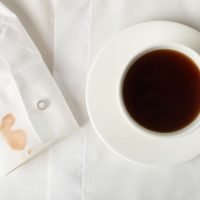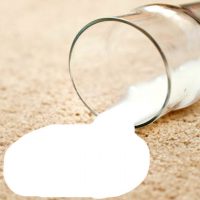Milk stains on clothes can be quite a hassle, especially if they are not removed immediately. But don’t worry, in this article I will tell you how to deal with this task and get your clothes back clean. In this guide, I’ll go into detail about the causes of stains, effective stain removal methods, and give helpful tips based on expert experience.
Causes of milk stains
Milk stains are caused by the proteins, fats, and carbohydrates contained in milk. When milk hits the fabric, these components are absorbed into the fibers and leave marks. Stains from high-fat dairy products such as cream or yogurt can be especially difficult to deal with.
Dr Jane Smith, fabric cleaning specialist, said: “A quick response to dairy stains can make removing stains much easier. Use cold water and mild detergents.”
Steps to Remove Fresh Milk Stains

If you notice a stain, do not delay removing it. The sooner you take action, the easier it will be to get rid of the stain.
- Blot the stain. Use a clean cloth or paper towel to remove as much dirt as possible. Avoid rubbing to avoid rubbing the stain deeper into the fabric.
- Rinse with cool water. Rinse the stain with cold water from the back of the fabric. Hot water can set the stain.
- Use soap or detergent. Apply a small amount of liquid detergent or soap to the stain and scrub gently.
How to Remove Dried Milk Stains
If the stain is already dry, it will take a little more effort.
- Soak the item. Soak clothes in cold water for 30 minutes.
- Use stain remover. Apply the stain remover to the stain and leave for 15-20 minutes.
- Wash the item. Wash your clothes in the washing machine following the instructions on the label.
Specialized stain removers
Using specialized products will help remove stains effectively. Here are some of them:
- Vanish Oxi Action: Effective against a variety of stains, including milk stains.
- Amway Prewash Spray: Easy to use, suitable for pre-treating stains.
Michael Johnson, household cleaning expert: “Modern stain removers contain enzymes that effectively break down proteins and fats, making them ideal for removing stains.”
Homemade Stain Remover Recipe
If you don’t have specialized products on hand, you can prepare a homemade mixture:
- 1 glass of cold water
- 1 teaspoon liquid detergent
- 1 tablespoon vinegar
Mix the ingredients and apply the mixture to the stain. Leave on for 15 minutes, then rinse with cool water.
Stain classification
There are different types of milk stains, and each requires a different approach:
- Fresh stains: Easier to remove if started immediately.
- Dried stains: require pre-soaking and use of stain remover.
- Grease stains: leave marks due to the high fat content of dairy products.
Scientific information about milk and stains
Milk contains proteins (casein and whey), fats and lactose. These components are deeply absorbed into fabrics, especially natural fibers such as cotton and wool. Proteins and fats can harden, making stains permanent.
Removing milk stains from different materials
Cotton
- Rinse the stain with cold water.
- Apply liquid detergent.
- Wash in a washing machine at low temperature.
Wool
- Blot the stain with cold water.
- Use a mild soap or shampoo on the coat.
- Rinse and dry naturally.
Synthetics
- Rinse with cool water.
- Apply stain remover.
- Wash at recommended temperature.
Step-by-step checklist for removing milk stains
- Blot the stain with a clean cloth.
- Rinse with cool water.
- Apply liquid detergent.
- Soak in cold water (for dry spots).
- Use stain remover.
- Wash clothes in a washing machine.
- Repeat as necessary.
Removing milk stains from clothes can be simple if you know the right techniques and products. Follow our tips and your clothes will always be clean and fresh. Share this article on social networks and bookmark it to always have effective stain removal methods at your fingertips.












